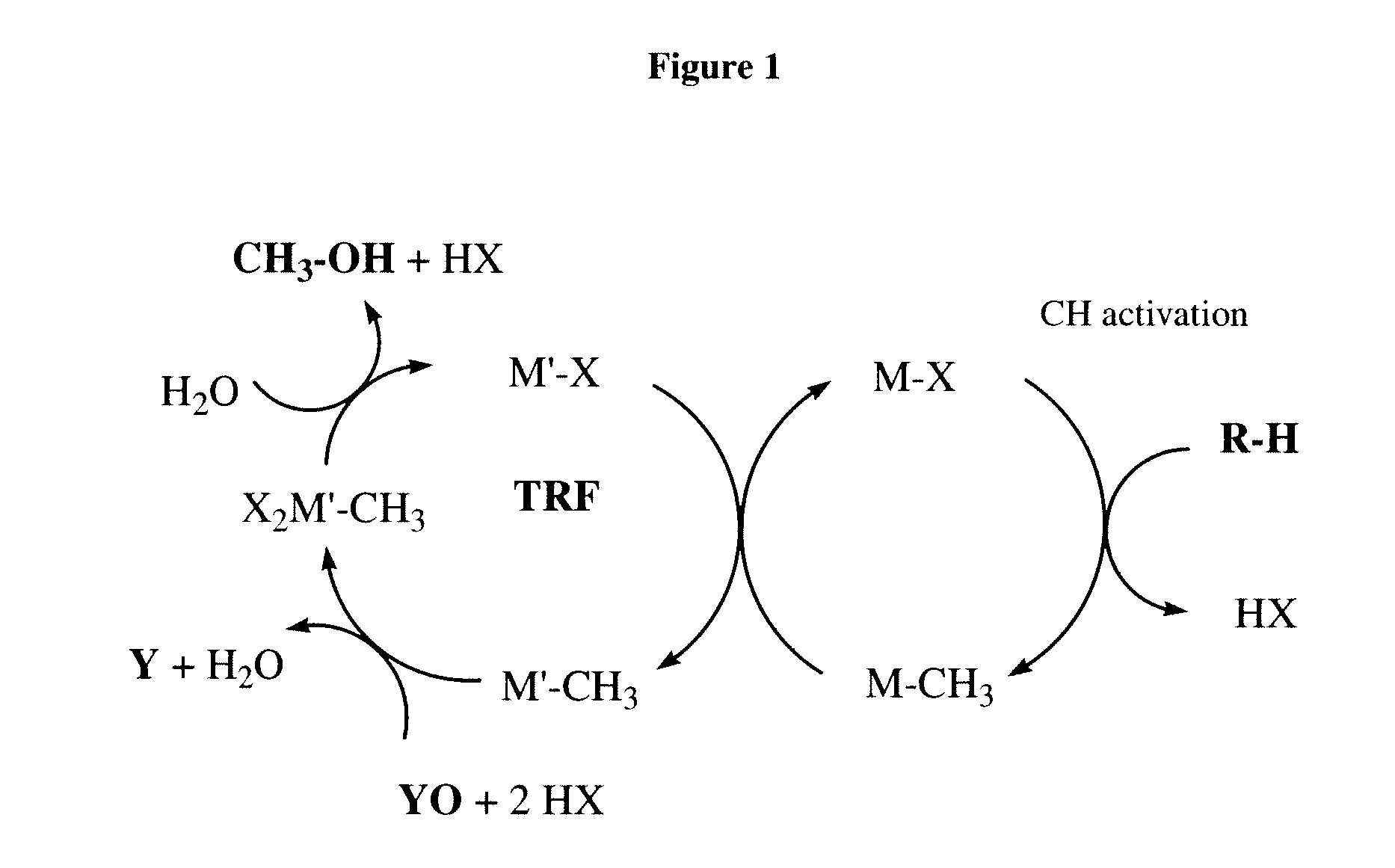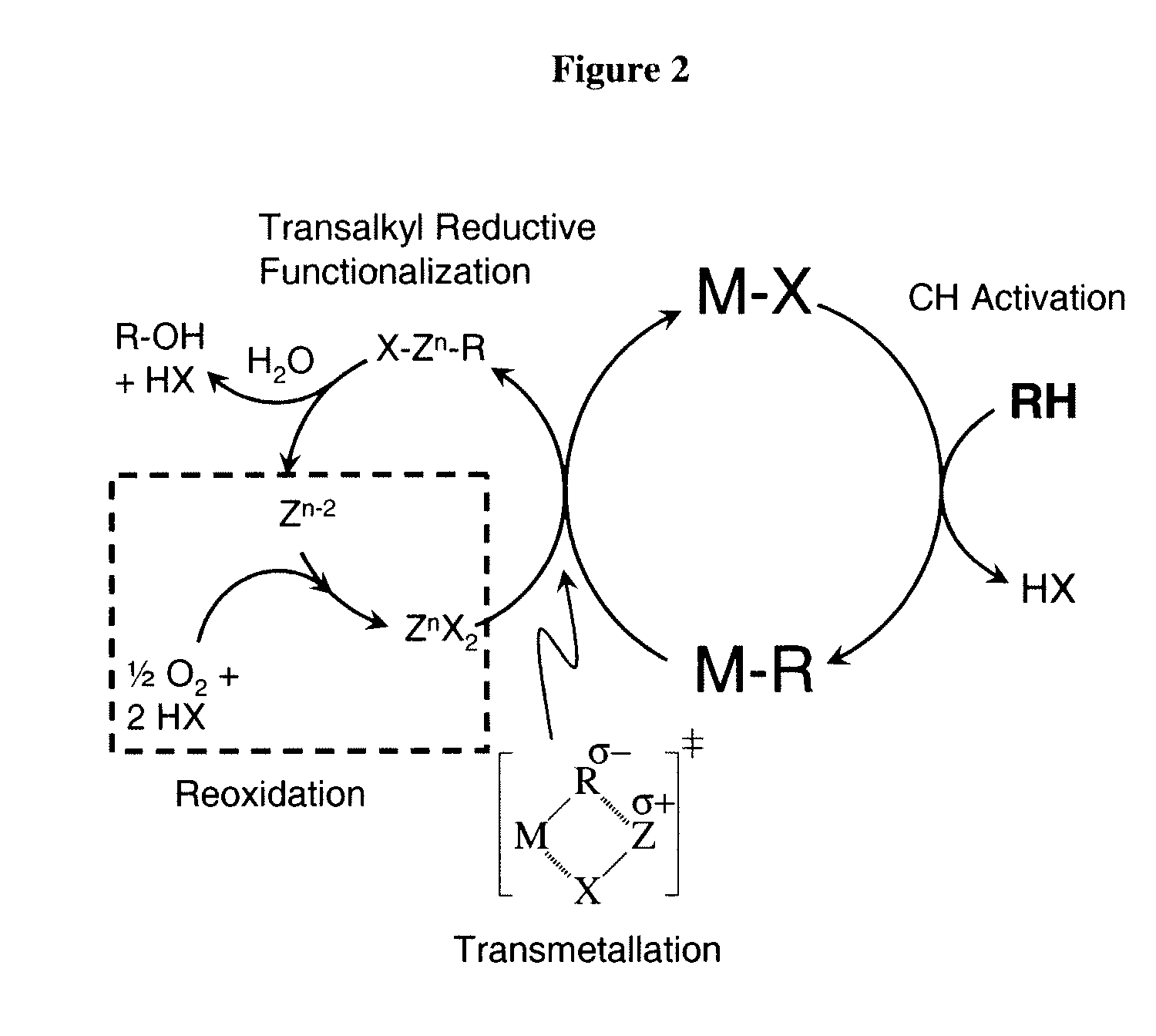Catalytic oxy-functionalization of metal-carbon bonds
- Summary
- Abstract
- Description
- Claims
- Application Information
AI Technical Summary
Benefits of technology
Problems solved by technology
Method used
Image
Examples
example 1
Reaction of CH3Re(CO)5 with PhIO as oxidant
[0097](CO)5ReCH3+PhIO: All reactions were carried out in 9:1 CD3CN / D2O in 8″ NMR tubes equipped with a resealable J-Young Teflon valve. Approximately 30 mg (0.088 mmol) of methyl rhenium(I) pentacarbonyl was charged to the NMR tube, followed by 3 equivalents of PhIO (58.08 mg, 0.264 mmol), followed by acetone-d6 (0.7 mL added), along with 0.6 μL of cyclohexane for use as an internal standard. All appropriate blanks were taken to assign solvent peaks, starting material peaks, and product (methanol) formation. Reactions were typically carried out under air at 100° C. for 4 h. 1H NMR indicated a 30 ±6% yield of methanol.
example 2
Reaction of CH3Re(CO)5 with KIO4 as oxidant
[0098]All reactions were carried out in 9:1 CD3CN / D2O in 8″ NMR tubes equipped with a resealable J-Young Teflon valve. Approximately 10 mg (0.088 mmol) of methyl rhenium(I) pentacarbonyl was charged to the NMR tube, followed by 3 equivalents of KIO4 (60.24 mg, 0.262 mmol), followed by CD3CN and D2O (9:1, 0.7 mL added), along with 0.6 μL of cyclohexane for use as an internal standard. All appropriate blanks were taken to assign solvent peaks, starting material peaks, and product (methanol) formation. Reactions were typically carried out under air at 100° C. for 12 h. 1H NMR indicated a 20 ±2% yield of methanol.
example 3
Reaction of CH3Re(CO)5 with H2SeO3 as oxidant
[0099]All reactions were carried out in 9:1 CD3CN / D2O in 8″ NMR tubes equipped with a resealable J-Young Teflon valve. Approximately 30 mg (0.088 mmol) methyl rhenium(I) pentacarbonyl was charged to the NMR tube, followed by 1 equivalent of SeO2 (9.76 mg, 0.088 mmol), followed by CD3CN and D2O (9:1, 0.7 mL added), along with 0.6 μL of cyclohexane for use as an internal standard. All appropriate blanks were taken to assign solvent peaks, starting material peaks, and product (methanol) formation. Reactions were typically carried out under air at 100° C. for 30 minutes. Yield of CH3SeO2H appeared quantitative by 1H NMR. CH3SeO2H(D) 1H NMR (9:1 CD3CN / D2O): δ 2.65(s, 3H, Se-CH3, 2JSe-H 13.2 Hz). 13C{1H} NMR (9:1 CD3CN / D2O): δ 42.2(Se-CH3, 1JSe-H 90.2 Hz).
PUM
 Login to View More
Login to View More Abstract
Description
Claims
Application Information
 Login to View More
Login to View More - R&D
- Intellectual Property
- Life Sciences
- Materials
- Tech Scout
- Unparalleled Data Quality
- Higher Quality Content
- 60% Fewer Hallucinations
Browse by: Latest US Patents, China's latest patents, Technical Efficacy Thesaurus, Application Domain, Technology Topic, Popular Technical Reports.
© 2025 PatSnap. All rights reserved.Legal|Privacy policy|Modern Slavery Act Transparency Statement|Sitemap|About US| Contact US: help@patsnap.com



